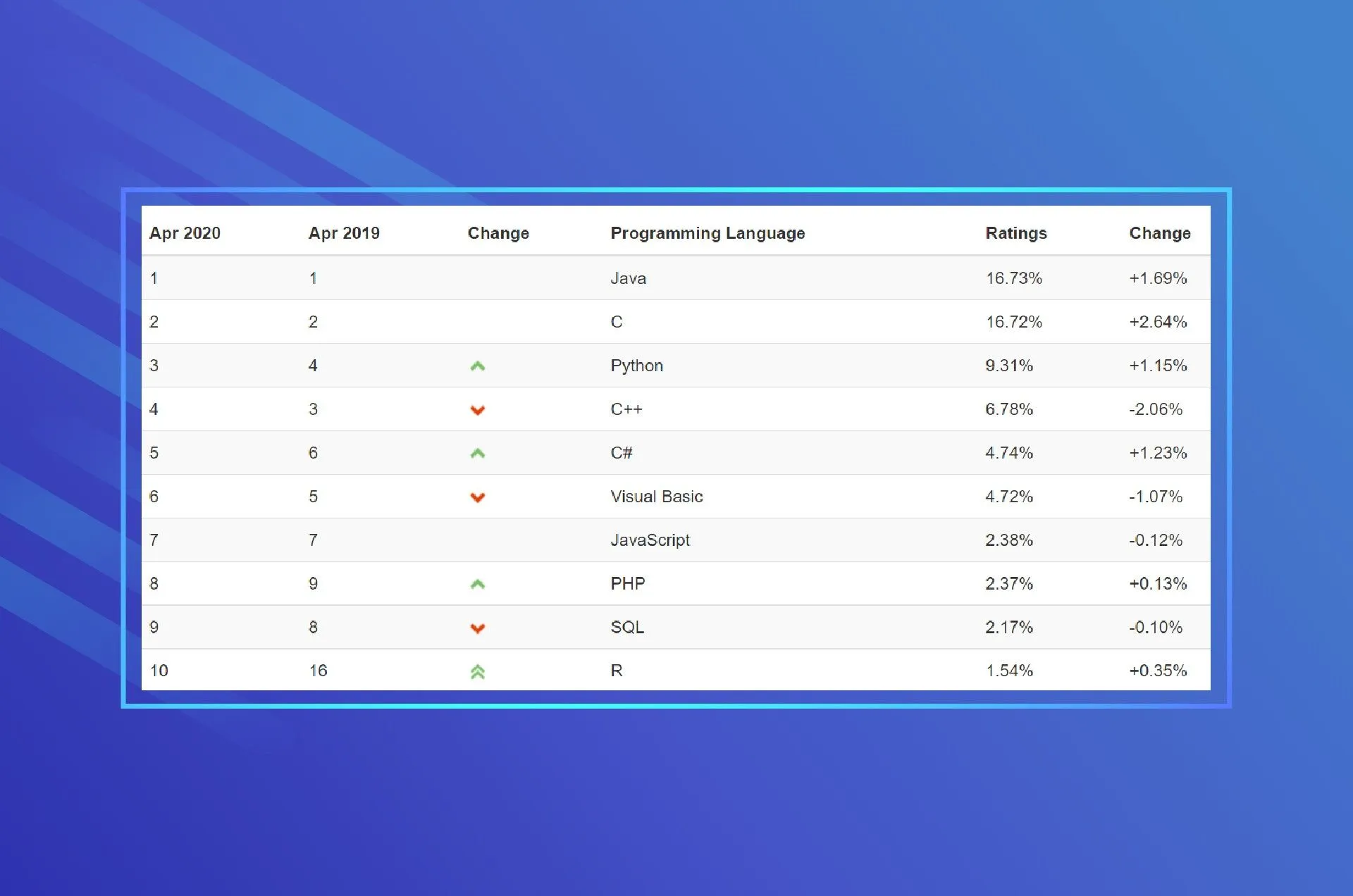Python Popularity: Seeking for Reasons
Table of contents
- Statistics on Python popularity over time
- The counterpoint to Python programming popularity
- So why is Python so popular with developers and beneficial to businesses?
- Python increases the productiveness of development.
- It is comparatively easy, both in terms of learning and working with it.
- The speed of applications written in Python does not negatively affect user experience.
- Python allows businesses to enjoy faster time-to-market.
- The benefits of Python beat the speed problem.
- Why is Python so popular today? Mind the key reasons
- IoT
- Data science and AI-based applications
- Web application development
- The Bottom Line
Since the introduction of Python in 1991 by Guido van Rossum, the language has changed considerably. Nevertheless, it is still used by developers, helping them to write clear, logical code for both small and large-scale projects.
But is Python popular today? In this blog post, we are going to provide you with information on statistics related to Python’s usage, highlight its main disadvantage, explain why the language is still popular among developers, point out benefits it brings to businesses, and show how it can be used — all to track its trend.
Statistics on Python popularity over time
Thanks to the stable and easily maintainable nature of applications written in Python, its popularity tends to increase year by year. The table below provides the answer to the question of how popular Python is today, comparing its and 9 more languages’ positions in 2020 to 2019.

But when did Python become popular and begin to top lists of programming languages? According to the TIOBE Index, it has become a language of the year 3 times since its introduction: in 2007, 2010, and 2018. What is more, in 2020, the PYPL Index recognized Python as the most popular language. It beat such well-established technologies as Java, Javascript, C#, PHP, C/C++, and others. You can take a look at the Python popularity graph over Java.

The statistics above imply the Python’s unambiguous trend. Nevertheless, there are still some doubts concerning its leading position among other languages, dictated by a commonly discussed disadvantage.
The counterpoint to Python programming popularity
Although one of the key reasons for Python’s popularity is that it is actually good for everything, there is still a significant disadvantage — speed. Below, we point out four factors that make it slower than other languages.
- Python has to abstract such details of the computer as memory management, pointers, etc., and for this reason, it loses many other technologies in terms of speed.
- Secondly, during the execution, Python’s code is interpreted at runtime. In contrast, a smart compiler optimizes for repeated or unneeded operations, speeding up the process of execution.
- Thirdly, Python is a dynamically typed language, so in comparison to statically-typed ones, it requests the declaration of the variable type like String, boolean or int, in this way requiring more work from a computer.
- Fourthly, the Python Global Interpreter Lock, or GIL, works in the way that threads are processed by the interpreter one by one, making multithreading impossible.
So why is Python so popular with developers and beneficial to businesses?
Despite being comparatively slow, the language remains popular in the development community for several good reasons.
Python increases the productiveness of development.
Because the Python language seems closest to English in terms of syntax, it requires less time and effort, making the development process more productive. In contrast, other programming languages like C++ and Java require more endeavors for the same operations.
It is comparatively easy, both in terms of learning and working with it.
The Python code is very simple and easy to read, which means that even those who have just started their career in programming are able to learn it with minimum efforts. Furthermore, Python generally needs much shorter lines of code than, say, Java, and in this way, it becomes a more efficient solution for development.
The speed of applications written in Python does not negatively affect user experience.
If the execution of a program does not take centuries, normally, end-users don’t care. In comparison to applications written in other languages, the speed of those written in Python differs in milliseconds. But even if the execution takes too long, and there are concerns about user experience, horizontal scaling allows solving this problem.
Python allows businesses to enjoy faster time-to-market.
As soon as nearly all modern computers have multi-core processors, the execution speed and performance issues are relegated to the position behind the business speed. Also, as we’ve mentioned before, the execution speed can be improved with horizontal scaling, while human costs can’t. Taking advantage of Python for development means reducing its time, so companies can enjoy faster time-to-market, increase their business speed, and improve competitiveness.
The benefits of Python beat the speed problem.
It is true that in most cases, the language suitability for a certain project is of higher importance than speed. When it comes to Python, it has a huge community, so finding and hiring Python developers is quite easy: both for development and maintenance purposes. For example, at Emerline, we have been using Python since 2009 for web development and the creation of API backend applications, as well as data analysis and processing. Inspired by the Python’s minimalist approach, we take advantage of this language for the development of solutions that perfectly suit the needs of both enterprise-level and small scale businesses.
Also, there is a wide range of frameworks and libraries Python offers. Python technologies we use at Emerline — Pyramid, Asyncio, Django, Tornado, Pandas, and others — allow us to cover a wide range of development needs. Considering this and other pros mentioned, it is worthy of saying that in 90% of cases, the Python’s speed-related problem does not matter at all.
Why is Python so popular today? Mind the key reasons
In addition to the above-mentioned benefits that this programming language brings to businesses and developers, Python has much more on offer. As we’ve already mentioned before, the language can be used for the development of nearly any sort of system or application, and here is where the key reasons for popularity of Python can be found. It is perfect for the creation of such trendy technological solutions as the Internet of Things (IoT), data science, and AI-based applications, as well as different kinds of web solutions.
IoT
IoT developers take advantage of Python quite often. Even though Java is still considered by many as the top technology for such purposes, Python programming popularity is largely driven by the rising trend for connected devices and related software solutions. The language opens up space for the creation of code that ensures communication between sensors, displays, robots, and other devices, as well as allows sending and receiving data through different communication channels (Internet, Bluetooth, etc.). Even though not all devices support Python, a majority of them do. Also, there is an option for programmers to utilize Micropython, which offers the advantage of extra simplicity and significantly speeds up the development.
Data science and AI-based applications
If you wonder how popular Python is, just try to find a better option for the development of applications that feature AI and ML, as well as cover the needs of data science. For sure, there is R — a language that is also widely used in data science. Nevertheless, its popularity drops from year to year because the more robust option exists — and it is exactly Python.
The Python language comes with a variety of built-in libraries that perfectly fit the needs of data science. Even if the technology needed for a certain project is not included in the box, it is always possible to download the one that will, whether it is NumPy, Pandas, matplotlib, SciPy, etc.
One more reason why Python is so popular in data science is that the easily understandable syntax of the language allows scientists to perform brightly with different kinds of tasks, including calculations, data analysis, etc.
Web application development
The advantages of Python also extend to web development purposes. For example, when it comes to the creation of web servers, Python can be used as a great alternative to such popular web development technologies as Java, Node.js, and .NET. Also, it is possible to take advantage of the Flask framework for system design, as well as Django for structuring and prototyping.
What makes Python stand out, is that it offers comparatively easy and quick coding, which can be performed even by less experienced developers. And for sure, the best case of using the language is when a combination of the above-mentioned solutions is required. Need a website featuring AI? Don’t hesitate to use Python as the core technology.
The Bottom Line
As you can see, there are enough strong reasons for Python’s popularity, as well as reasons to use the language as the key technology for your project: starting from the goal to increase business speed, continuing with looking ahead to maintenance needs, and pursuing the objectives to implement AI, ML, IoT technologies into your business strategy.
For sure, Python should not be considered as a programming panacea, because there are tons of projects that are better to be developed with Java, .NET, C#, etc. The key point is that we should not underestimate Python's potential and value.
Anyway, if you are not sure whether Python is the best option for your project, we are here to help you with finding the answer. So please, feel free to contact us anytime.
Published on Dec 15, 2022





